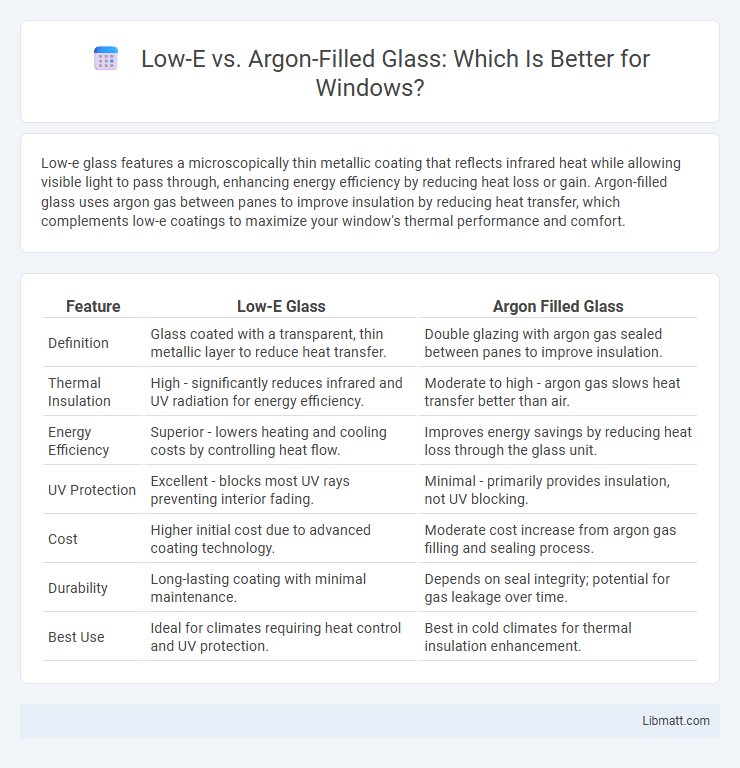Low-e glass features a microscopically thin metallic coating that reflects infrared heat while allowing visible light to pass through, enhancing energy efficiency by reducing heat loss or gain. Argon-filled glass uses argon gas between panes to improve insulation by reducing heat transfer, which complements low-e coatings to maximize your window's thermal performance and comfort.
Table of Comparison
| Feature | Low-E Glass | Argon Filled Glass |
|---|---|---|
| Definition | Glass coated with a transparent, thin metallic layer to reduce heat transfer. | Double glazing with argon gas sealed between panes to improve insulation. |
| Thermal Insulation | High - significantly reduces infrared and UV radiation for energy efficiency. | Moderate to high - argon gas slows heat transfer better than air. |
| Energy Efficiency | Superior - lowers heating and cooling costs by controlling heat flow. | Improves energy savings by reducing heat loss through the glass unit. |
| UV Protection | Excellent - blocks most UV rays preventing interior fading. | Minimal - primarily provides insulation, not UV blocking. |
| Cost | Higher initial cost due to advanced coating technology. | Moderate cost increase from argon gas filling and sealing process. |
| Durability | Long-lasting coating with minimal maintenance. | Depends on seal integrity; potential for gas leakage over time. |
| Best Use | Ideal for climates requiring heat control and UV protection. | Best in cold climates for thermal insulation enhancement. |
Introduction to Energy-Efficient Glass Solutions
Low-e glass features a microscopically thin coating that reflects infrared energy, reducing heat transfer and enhancing your window's insulation performance. Argon-filled glass utilizes argon gas between panes to decrease thermal conductivity, improving energy efficiency and reducing heating and cooling costs. Both technologies contribute significantly to energy-efficient window solutions, with low-e coatings primarily controlling solar heat gain and argon gas enhancing thermal insulation.
What is Low-E Glass?
Low-E glass features a microscopically thin coating that reflects infrared energy while allowing visible light to pass through, improving energy efficiency in windows. Compared to argon-filled glass, which uses inert gas between panes to reduce heat transfer, Low-E coatings actively block radiant heat, keeping interiors cooler in summer and warmer in winter. Your choice of Low-E glass enhances thermal performance and reduces energy costs more effectively than argon-filled units alone.
What is Argon-Filled Glass?
Argon-filled glass features a layer of argon gas sealed between two panes of glass, significantly enhancing insulation by reducing heat transfer. This inert gas minimizes convection and improves energy efficiency, making windows warmer in winter and cooler in summer. Your home benefits from reduced energy costs and improved comfort with argon-filled glass compared to standard glazing.
How Low-E Glass Improves Home Efficiency
Low-E glass enhances home efficiency by reflecting infrared heat back into the room while allowing natural light to enter, reducing heating costs in winter. Argon-filled glass improves insulation by minimizing heat transfer between panes, but Low-E coatings specifically target radiant heat control. Combining Low-E coating with argon gas further boosts energy efficiency, lowering utility bills and increasing indoor comfort year-round.
Benefits of Argon Gas in Insulated Glass Units
Argon gas enhances insulated glass units by providing superior thermal insulation compared to air, reducing heat transfer and improving energy efficiency in your windows. This inert gas minimizes condensation and prevents heat loss, resulting in a more comfortable indoor environment and lower HVAC costs. Combining argon-filled glass with low-e coatings maximizes insulation performance, making it an ideal choice for energy-conscious homeowners.
Low-E vs Argon-Filled Glass: Key Differences
Low-E glass features a microscopically thin metallic coating that reflects infrared energy, reducing heat transfer and improving energy efficiency, while argon-filled glass uses inert gas between panes to enhance insulation by minimizing thermal conductivity. Low-E coatings primarily control solar heat gain and UV radiation, making interiors more comfortable and protecting furnishings from fading. In contrast, argon gas improves the overall thermal performance of double or triple-pane windows but does not affect solar heat gain or UV protection.
Performance Comparison: Low-E and Argon Glass
Low-E glass features a microscopically thin coating that reflects infrared energy, improving insulation by reducing heat transfer, while argon-filled glass enhances thermal performance by filling the space between panes with argon gas, which has lower thermal conductivity than air. Combining Low-E coatings with argon gas significantly boosts energy efficiency, offering better temperature regulation and reduced UV damage inside your home. Choosing windows with both Low-E and argon filling optimizes performance, resulting in lower energy bills and increased comfort.
Cost Considerations for Low-E and Argon Glass Windows
Low-E glass windows typically come at a higher initial cost due to advanced coatings designed to improve energy efficiency by reflecting infrared heat. Argon-filled glass adds moderate expense compared to traditional windows but enhances insulation by reducing heat transfer between panes. Balancing your budget and energy savings goals will determine whether investing in Low-E coatings, argon gas fills, or a combination of both provides the best value for your home.
Ideal Applications: When to Choose Low-E or Argon Glass
Low-E glass is ideal for energy-efficient windows in residential and commercial buildings, providing superior insulation by reflecting heat while allowing natural light. Argon-filled glass is best suited for colder climates where enhanced thermal insulation between panes reduces heat loss and prevents condensation. Your choice should consider climate, energy savings, and window performance priorities to maximize comfort and efficiency.
Conclusion: Which Glass Type Is Best for Your Needs?
Low-e glass excels in reflecting infrared heat, enhancing energy efficiency by minimizing heat loss, while argon-filled glass improves insulation through a denser gas layer between panes, reducing heat transfer. Choosing the best option depends on your climate and priorities: low-e glass is ideal for controlling solar heat gain and maintaining indoor temperatures, whereas argon-filled glass is preferred for stronger thermal insulation and soundproofing. Combining both features in double or triple glazing often offers superior overall performance, balancing energy savings and comfort.
low-e vs argon filled glass Infographic

 libmatt.com
libmatt.com